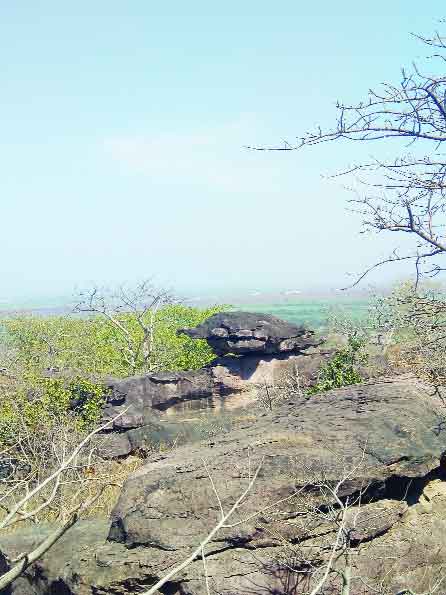MUSBA HASHMI brings you a report on the world’s oldest rock art shelters at Bhimbetka
Amidst the deserted area of Bhimbetka lies the ancient caves from the early human period. These rock shelters represent the prehistoric era — paleolithic and mesolithic period. It has been recognised as the World Heritage site in July, 2003. Bhimbetka was discovered by Professor Vishnu Shridhar Wakankar in the late 1950s. The area is said to be an accidental discovery by the professor while he was returning to his home in Pune.
It is believed that Bhimbetka derived its name from the Mahabharat, which means ‘sitting place of Bhima’. The folklore has it that the five pandavas took shelter in the place after they were banished from the kingdom.
The area is dry and deserted and there are no flowers except for bougainvillea which can be found growing on a few trees. A thin, uncemented road leads you towards the site. To get to the location, it’s better to have your vehicle. On your way, around 3 km ahead of the site you can have a break at Highway Treat and treat yourself with some nice tastes like home food.
Around 500 people visit the rock shelters every day and the number rises up to 1,000 during holidays. Though the site is yet to receive its deserved fame which is spread over an area of 10 km with over 750 rock shelters.
A total of two hours is needed to explore each point. So, when planning to visit the site you must have ample time in hand and must be ready for a good long walk.
On every rock shelter there are paintings which are said to be made by the early humans because it was their way of communication and expression of their feelings. The paintings are made using two colours — white and red. The red colour, said to have been derived from blood.
“You can see paintings on every rock shelter which depicts the activities of the early humans. These early humans are believed to be from the Gond tribe. From their hunting practice to their celebrations and to their daily activities of doing the household chores, everything is shown on these paintings. Some of the paintings resemble the Madhubani art form,” Ravi Kumar Yadav, a registered tourist guide at Bhimbetka tells you.
These caves are a home to thousands of bats which can be seen hanging upsuide down during the day. The presence of these creatures can also be felt because of the persistent pungent smell in the caves. The caves have been made in such a way that it resembles our modern day homes. With bedroom to drawing room to dining room and kitchen, you can figure out how these caves were used for different things. Whether it is a mere co-incidence or misinterpretation or if the early humans truly lived this way, no one can tell. But if they were able to divide the work areas, it says a lot about the pre-historic man
One of the most significant feature of the site is the auditorium cave which is said to be like a catholic environment because of its gothic arches and the structure resembles a right-angled cross. This rock shelter is surrounded by the quartzite towers, which are visible from a several kilometres distance also.
Animals like deer, bison, tigers, wild boar, elephants, monkey, antelope and rhinoceros have been depicted in most of the paintings on the rock shelters. Every painting portrays human hunting animals or having a feast on them, but in the biggest painting made on the boar rock, it shows a huge animal hunting humans.
“In every painting you will find humans hunting animals, but one painting on the rocks show that it was the other way round too. The biggest painting which is made on the boar rock, shows a horned beast hunting humans — may be a wild boar. There are different types of rock shelters in the site like the turtle rock, the lion rock, the mushroom rock and others. They all derived their names from the shape which they resemble” Yadav tells you adding that some of the paintings are losing their colour because of the lack of maintenance.
“In 2001, Archaeological Survey of India tried to do a chemical treatment on the rocks to protect them but the paintings started losing their colours immediately. The process was stopped halfway and since then no preventive measures have been taken to maintain or protect this heritage site. Algae has started spreading over these rocks and it needs to be treated,” Yadav says.
Surendra Singh Baghel, Tourism Minister, Madhya Pradesh said: “The Government will take some serious actions to protect the caves of Bhimbetka and its heritage. We will make sure that proper care is taken of the caves and the paintings. It is indeed very precious for us.”
Yadav explains that in his 14-year-old career he have only met a dozen or so people who truly wanted to study the site and explore it, others just come in for a quick round.
“I have met only 10-12 people till now who took interest in knowing more about the caves and wanted to study them. Others just come-in to have an overview of the place. But, the site requires time in order to understand and know it to some extent. But due to lack of time majority of the tourists wants to have an overview of the place in just two hours, which is not possible. The site deserves time and curiosity,” Yadav tells you.
The site is a true escape from the hustle and bustle of the fast-paced cities. One can truly have a sigh of relief after getting here — from the pollution and stress of the big cities. Visit the place for the love of historic things and a curiosity to go back in the early human time.


























